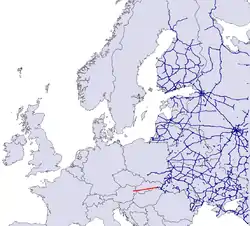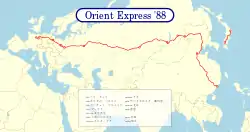Košice–Vienna broad-gauge line
The Košice–Vienna broad-gauge line (Slovak: Široká koľaj do Viedne, German: Breitspurstrecke Košice–Wien) is an international project to extend the 1,520 mm (4 ft 11+27⁄32 in) Russian gauge (broad-gauge) railway line from the city of Košice in eastern Slovakia to Vienna and Bratislava.[1][2] It will result in the creation of an 8,000-kilometre (5,000-mile)[1] rail transport corridor linking Western Europe and China.[3]

Košice–Vienna broad-gauge line | ||||||||||||||||||||||||||||||||||||||||||||||||||||||||||||||||||||||||||||||||||||||||||||||||||||||||||||||||||||||||||||||||||||||||||||||||||||||||||||||||||||||||||||||||||||||||||||||||||||||||||||||||||||||||||||||||||||||||||||||||||||||||||||||||||||||||||||||||||||||||||||||||||||||||||||||||||||||||||||||||||
|---|---|---|---|---|---|---|---|---|---|---|---|---|---|---|---|---|---|---|---|---|---|---|---|---|---|---|---|---|---|---|---|---|---|---|---|---|---|---|---|---|---|---|---|---|---|---|---|---|---|---|---|---|---|---|---|---|---|---|---|---|---|---|---|---|---|---|---|---|---|---|---|---|---|---|---|---|---|---|---|---|---|---|---|---|---|---|---|---|---|---|---|---|---|---|---|---|---|---|---|---|---|---|---|---|---|---|---|---|---|---|---|---|---|---|---|---|---|---|---|---|---|---|---|---|---|---|---|---|---|---|---|---|---|---|---|---|---|---|---|---|---|---|---|---|---|---|---|---|---|---|---|---|---|---|---|---|---|---|---|---|---|---|---|---|---|---|---|---|---|---|---|---|---|---|---|---|---|---|---|---|---|---|---|---|---|---|---|---|---|---|---|---|---|---|---|---|---|---|---|---|---|---|---|---|---|---|---|---|---|---|---|---|---|---|---|---|---|---|---|---|---|---|---|---|---|---|---|---|---|---|---|---|---|---|---|---|---|---|---|---|---|---|---|---|---|---|---|---|---|---|---|---|---|---|---|---|---|---|---|---|---|---|---|---|---|---|---|---|---|---|---|---|---|---|---|---|---|---|---|---|---|---|---|---|---|---|---|---|---|---|---|---|---|---|---|---|---|---|---|---|---|---|---|---|---|---|---|---|---|---|---|---|---|---|---|---|---|---|---|---|---|---|
| ||||||||||||||||||||||||||||||||||||||||||||||||||||||||||||||||||||||||||||||||||||||||||||||||||||||||||||||||||||||||||||||||||||||||||||||||||||||||||||||||||||||||||||||||||||||||||||||||||||||||||||||||||||||||||||||||||||||||||||||||||||||||||||||||||||||||||||||||||||||||||||||||||||||||||||||||||||||||||||||||||
The project is part of the Eurasian Land Bridge initiative to create a continuous rail connection between Europe and East Asia.[4]
Broad gauge
The most commonly used railway gauge in Western Europe is 1,435 mm (4 ft 8+1⁄2 in), while Eastern Europe uses 1,520 mm (60 in).[5][6] Russian gauge railways link more than 15 countries, including the Commonwealth of Independent States, the Baltic states, Mongolia and Finland. This gauge is the primary gauge of Russia's railways, making it possible to transport freight directly from Eastern Europe to the Far East.

In total, there are over 150,000 kilometres (93,000 mi) of Russian gauge railway lines, comprising 18% of all rail lines in the world.[7]
There are several individual Russian gauge lines in countries where this gauge is not the standard, including:
- In Poland: the 400-kilometre (250 mi)-long Broad Gauge Metallurgy Line – (Polish: Linia Hutnicza Szerokotorowa, known by its abbreviation LHS);
- In Romania: the line connecting Moldova and the iron and steel works at Galați;
- In Slovakia: broad-gauge lines from Uzhhorod (Matevce) to Košice and from Čierna nad Tisou to Chop (Ukraine).
The westernmost point on the broad-gauge network is in the town of Sławków in southern Poland, where the LHS ends.
Moving freight on the broad-gauge network is considered less expensive, as the lines can take more cargo (higher axle weight limits and higher maximum trainloads).[5][8] Wider rolling stock can also be used on this gauge.
New railway lines to Vienna

The aim of the project is to expand European rail network by laying Russian gauge tracks from Košice in eastern Slovakia to Vienna, creating an uninterrupted transport chain from Russia, China, Japan and other Asian countries to Central Europe. This will directly connect the European railway network (as well as the Danube River transport system) with the Trans-Siberian Railway.[9]
The vast majority of freight shipments between the EU, Russia and the Asian Pacific Region currently go by sea via the Suez Canal, a distance of between 17,000 and 22,000 kilometres (11,000 and 14,000 mi). By extending the broad-gauge line, the promoters of the Košice–Vienna project aim to make the Trans-Siberian Railway more competitive vis-à-vis the sea routes. By eliminating the need to change bogies, freight delivery times from East Asia to Europe will be cut by 14 days to just half of the time required for transportation by sea. And as there will be no freight transshipment the risk of accidental damage to cargo could be reduced.[6] Russian Railways CEO Vladimir Yakunin believes it is the faster freight delivery that will make the project competitive.[4]

The project will require a 450-kilometre (280 mi) extension to the broad-gauge line and associated infrastructure, as well as reconstruction of the existing Russian gauge railway line within Slovakia, from the border station at Matovce to Haniska pri Kosiciach (Košice) – a distance of 87 kilometres (54 mi). A new transport terminal will also be built in the vicinity of Vienna and Bratislava.[1]
The new track is to be laid alongside the existing standard gauge line.[2] Commissioning of the new line is planned by 2025.[5][6][10] The Vienna–Bratislava transport hub will become the most westerly point on the Russian gauge network.[4]
History of the project
The idea of building a Russian gauge broad-gauge railway line from Haniska pri Košiciach station to Eastern Europe was first suggested by Russian Railways CEO Vladimir Yakunin in May 2006 at the Strategic Partnership 1520 international forum. In 2008, Russia, Ukraine, Slovakia and Austria set up a joint company to build the broad-gauge line from the Slovak city of Košice to the international logistics terminal in Vienna.[6][11] The company was given the name Breitspur Planungsgesellschaft mbH and is equally owned by the national railway companies of the participating countries (ÖBB, ŽSR, UZ and Russian Railways).[1][2][11]
On 6 April 2010, a four-party agreement was signed between the participating countries. Russia was represented at that meeting by its president, Dmitry Medvedev.[6][12]
In December 2010 Roland Berger Strategy Consultants completed a project feasibility study. According to the published findings of this study, there are no technical or legal barriers to implementing the project.[2]
In June 2012, a delegation from the EU led by Transport Commissioner Siim Kallas voiced its support for the project at a conference in Sochi.[4]
In August 2013, the participating countries announced a tender for technical design work on the project infrastructure.[1]
In March 2014, Russian Railways CEO Vladimir Yakunin announced a project to link Europe and Asia via a multi-purpose transport corridor known as the Trans-European Development Belt. The project envisages laying not only long-distance railway lines, but also pipelines for the transportation of oil, gas, water and power, as well as all types of communication from the Pacific Ocean to the Atlantic.[13]
In May 2021, the Austrian government stated that it has no plans to approve the construction of the line.[14]
Finance

Preliminary estimates place the cost of the project at 6.3 billion euros. A further €240 million will be required for the terminals and €130 million for additional rolling stock.[2]
Freight traffic between Košice and Bratislava could reach 24 million tonnes per annum by 2025 (19 million tonnes between Bratislava and Vienna).[6] During the construction and operation the project will create 642,000 new jobs[1] (including 11,000 jobs connected with work on the new line infrastructure[5]). The project could also provide a boost of 12 billion euros to the GDPs of the participating countries.[1]
Market research shows that most of the freight moving westwards along the new route will be containers, iron ore and metals.[6] 30% of all cargo will be transported from west to east. The project will link up freight flows from 37 countries across Eurasia.[1]
Siim Kallas believes that rail traffic between the EU and its eastern neighbours is likely to increase by 30% between 2007 and 2020.[9]
Russian Railways plans to invest $2–3 billion in the project, which it will raise by issuing Eurobonds.[9]
Opinions
Siim Kallas thinks that the main problem with this project is the customs fees in Russia, which result in international freight forwarders paying more than Russian companies.[4]
In the view of Polish representatives, the project has a political subtext in that it could potentially be used to economically isolate Poland and its lone Russian-gauge railway line that also originates in Ukraine.[9]
In 2013, Ukrainian Railways Director General Sergei Bolobolin has stated that the project is vitally important for Ukraine and the entire European transport system.[1]
References
- "A step forward in the development of Košice-Vienna broad gauge line". Railway PRO Communication Platform. 2013-08-26. Retrieved 2019-03-20.
- Ltd, DVV Media International. "Broad gauge to Wien is feasible, says study". Railway Gazette. Retrieved 2019-03-20.
- "Breitspur Planungsgesellschaft - The Idea". www.breitspur.com. Archived from the original on 2015-02-07. Retrieved 2019-03-20.
- Oliphant, Roland (6 June 2012). "Railway Plans 'Land Bridge' Between China and Europe". The St. Petersburg Times. No. 1711. p. 1. Archived from the original on 1 March 2014.
- "Broad gauge rail link from Ukraine to Vienna pushed by Slovakia". Ukraine Business Online. 25 January 2011. Archived from the original on 6 December 2014. Retrieved 19 March 2019.
- Ltd, DVV Media International. "Wien broad gauge agreement signed". Railway Gazette. Retrieved 2019-03-20.
- "About 1,520 mm gouge [sic]". forum1520.com. Retrieved 2019-03-20.
- Ltd, DVV Media International. "Accords signed to bring broad gauge to Wien". Railway Gazette. Retrieved 2019-03-20.
- Oliphant, Roland (6 June 2012). "Railway Plans 'Land Bridge' Between China and Europe". The St. Petersburg Times. No. 1711. p. 2. Archived from the original on 26 December 2014.
- "Добраться до Вены: как события в Украине нивелировали прорыв РЖД в Европе". cfts.org.ua (in Russian). Retrieved 2019-03-20.
- "Breitspur Planungsgesellschaft - History". www.breitspur.com. Archived from the original on 2014-12-13. Retrieved 2019-03-20.
- TREND.sk. "Širokorozchodnú trať chcú Rusi ťahať cez celé Slovensko až do Viedne". www.etrend.sk (in Slovak). Retrieved 2019-03-20.
- "Cоздание "Транс-Евразийского пояса развития" | Корпоративное телевидение ОАО "РЖД"". 2015-09-24. Archived from the original on 2015-09-24. Retrieved 2019-03-20.
- Fender, Keith (6 May 2021). "Austrian government will not support broad gauge line". International Railway Journal.